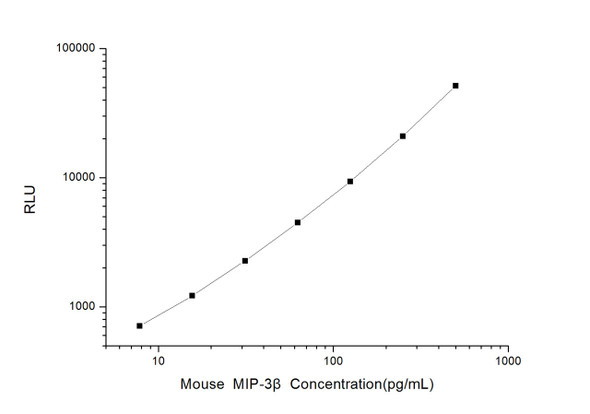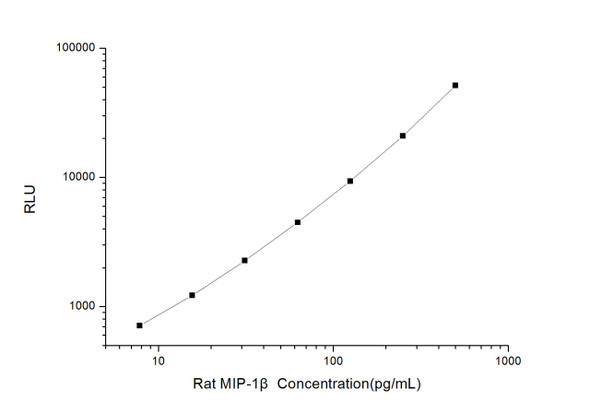Human Cell Biology ELISA Kits 5
Human MIP-3 beta/ELC/CCL19 (Macrophage Inflammatory Protein 3 beta) CLIA Kit (HUES00866)
- SKU:
- HUES00866
- Product Type:
- ELISA Kit
- ELISA Type:
- CLIA Kit
- Size:
- 96 Assays
- Sensitivity:
- 4.69pg/mL
- Range:
- 7.81-500pg/mL
- ELISA Type:
- Sandwich
- Reactivity:
- Human
- Sample Type:
- Serum, plasma and other biological fluids
- Research Area:
- Cell Biology
Description
| Assay type: | Sandwich |
| Format: | 96T |
| Assay time: | 4.5h |
| Reactivity: | Human |
| Detection method: | Chemiluminescence |
| Detection range: | 7.81-500 pg/mL |
| Sensitivity: | 4.69 pg/mL |
| Sample volume: | 100µL |
| Sample type: | Serum, plasma and other biological fluids |
| Repeatability: | CV < 15% |
| Specificity: | This kit recognizes Human MIP-3 beta/ELC/CCL19 in samples. No significant cross-reactivity or interference between Human MIP-3 beta/ELC/CCL19 and analogues was observed. |
This kit uses Sandwich-CLIA as the method. The micro CLIA plate provided in this kit has been pre-coated with an antibody specific to Human MIP-3 beta/ELC/CCL19. Standards or samples are added to the appropriate micro CLIA plate wells and combined with the specific antibody. Then a biotinylated detection antibody specific for Human MIP-3 beta/ELC/CCL19 and Avidin-Horseradish Peroxidase (HRP) conjugate are added to each micro plate well successively and incubated. Free components are washed away. The substrate solution is added to each well. Only those wells that contain Human MIP-3 beta/ELC/CCL19, biotinylated detection antibody and Avidin-HRP conjugate will appear fluorescence. The Relative light unit (RLU) value is measured spectrophotometrically by the Chemiluminescence immunoassay analyzer. The RLU value is positively associated with the concentration of Human MIP-3 beta/ELC/CCL19. The concentration of Human MIP-3 beta/ELC/CCL19 in the samples can be calculated by comparing the RLU of the samples to the standard curve.
| UniProt Protein Function: | CCL19: May play a role not only in inflammatory and immunological responses but also in normal lymphocyte recirculation and homing. May play an important role in trafficking of T-cells in thymus, and T-cell and B-cell migration to secondary lymphoid organs. Specifically binds to chemokine receptor CCR7. Recombinant CCL19 shows potent chemotactic activity for T-cells and B-cells but not for granulocytes and monocytes. Belongs to the intercrine beta (chemokine CC) family. |
| UniProt Protein Details: | Protein type:Secreted; Secreted, signal peptide; Motility/polarity/chemotaxis Chromosomal Location of Human Ortholog: 9p13 Cellular Component: extracellular space; extracellular region Molecular Function:CCR chemokine receptor binding; chemokine activity; chemokine receptor binding; CCR10 chemokine receptor binding; CCR7 chemokine receptor binding Biological Process: formation of immunological synapse; positive regulation of interleukin-12 production; positive regulation of dendritic cell antigen processing and presentation; cell maturation; positive regulation of JNK cascade; positive regulation of endocytosis; positive regulation of NF-kappaB import into nucleus; positive regulation of interleukin-1 beta secretion; activation of JNK activity; positive regulation of receptor-mediated endocytosis; dendritic cell chemotaxis; cell communication; establishment of T cell polarity; positive regulation of T cell proliferation; inflammatory response; positive regulation of I-kappaB kinase/NF-kappaB cascade; positive regulation of chemotaxis; response to virus; positive regulation of phosphoinositide 3-kinase activity; positive regulation of tumor necrosis factor production; cellular calcium ion homeostasis; positive regulation of protein kinase B signaling cascade; myeloid dendritic cell chemotaxis; release of sequestered calcium ion into cytosol; positive regulation of protein kinase activity; T cell costimulation; immune response; positive regulation of T-helper 1 cell differentiation |
| NCBI Summary: | This antimicrobial gene is one of several CC cytokine genes clustered on the p-arm of chromosome 9. Cytokines are a family of secreted proteins involved in immunoregulatory and inflammatory processes. The CC cytokines are proteins characterized by two adjacent cysteines. The cytokine encoded by this gene may play a role in normal lymphocyte recirculation and homing. It also plays an important role in trafficking of T cells in thymus, and in T cell and B cell migration to secondary lymphoid organs. It specifically binds to chemokine receptor CCR7. [provided by RefSeq, Sep 2014] |
| UniProt Code: | Q99731 |
| NCBI GenInfo Identifier: | 2842763 |
| NCBI Gene ID: | 6363 |
| NCBI Accession: | Q99731. 1 |
| UniProt Secondary Accession: | Q99731,O00697, O00736, |
| UniProt Related Accession: | Q99731 |
| Molecular Weight: | 10,993 Da |
| NCBI Full Name: | C-C motif chemokine 19 |
| NCBI Synonym Full Names: | chemokine (C-C motif) ligand 19 |
| NCBI Official Symbol: | CCL19 |
| NCBI Official Synonym Symbols: | ELC; CKb11; MIP3B; MIP-3b; SCYA19 |
| NCBI Protein Information: | C-C motif chemokine 19; exodus-3; CK beta-11; MIP-3-beta; EBI1 ligand chemokine; EBI1-ligand chemokine; CC chemokine ligand 19; beta chemokine exodus-3; beta-chemokine exodus-3; small-inducible cytokine A19; macrophage inflammatory protein 3 beta; macrophage inflammatory protein 3-beta; epstein-Barr virus-induced molecule 1 ligand chemokine; small inducible cytokine subfamily A (Cys-Cys), member 19 |
| UniProt Protein Name: | C-C motif chemokine 19 |
| UniProt Synonym Protein Names: | Beta-chemokine exodus-3; CK beta-11; Epstein-Barr virus-induced molecule 1 ligand chemokine; EBI1 ligand chemokine; ELC; Macrophage inflammatory protein 3 beta; MIP-3-beta; Small-inducible cytokine A19 |
| UniProt Gene Name: | CCL19 |
| UniProt Entry Name: | CCL19_HUMAN |
As the RLU values of the standard curve may vary according to the conditions of the actual assay performance (e. g. operator, pipetting technique, washing technique or temperature effects), the operator should establish a standard curve for each test. Typical standard curve and data is provided below for reference only.
| Concentration (pg/mL) | RLU | Average | Corrected |
| 500 | 50517 52557 | 51537 | 51508 |
| 250 | 19112 22884 | 20998 | 20969 |
| 125 | 9401 9391 | 9396 | 9367 |
| 62.5 | 4319 4705 | 4512 | 4483 |
| 31.25 | 2434 2164 | 2299 | 2270 |
| 15.63 | 1268 1232 | 1250 | 1221 |
| 7.81 | 701 779 | 740 | 711 |
| 0 | 28 30 | 29 | -- |
Precision
Intra-assay Precision (Precision within an assay): 3 samples with low, mid range and high level Human MIP-3 beta/ELC/CCL19 were tested 20 times on one plate, respectively.
Inter-assay Precision (Precision between assays): 3 samples with low, mid range and high level Human MIP-3 beta/ELC/CCL19 were tested on 3 different plates, 20 replicates in each plate.
| Intra-assay Precision | Inter-assay Precision | |||||
| Sample | 1 | 2 | 3 | 1 | 2 | 3 |
| n | 20 | 20 | 20 | 20 | 20 | 20 |
| Mean (pg/mL) | 24.66 | 74.00 | 201.06 | 24.25 | 69.15 | 217.53 |
| Standard deviation | 3.00 | 6.76 | 18.82 | 2.32 | 5.38 | 21.82 |
| C V (%) | 12.17 | 9.14 | 9.36 | 9.57 | 7.78 | 10.03 |
Recovery
The recovery of Human MIP-3 beta/ELC/CCL19 spiked at three different levels in samples throughout the range of the assay was evaluated in various matrices.
| Sample Type | Range (%) | Average Recovery (%) |
| Serum (n=5) | 93-110 | 101 |
| EDTA plasma (n=5) | 94-107 | 101 |
| Cell culture media (n=5) | 86-96 | 91 |
Linearity
Samples were spiked with high concentrations of Human MIP-3 beta/ELC/CCL19 and diluted with Reference Standard & Sample Diluent to produce samples with values within the range of the assay.
| Serum (n=5) | EDTA plasma (n=5) | Cell culture media (n=5) | ||
| 1:2 | Range (%) | 92-103 | 90-102 | 100-113 |
| Average (%) | 98 | 96 | 106 | |
| 1:4 | Range (%) | 91-103 | 84-98 | 88-101 |
| Average (%) | 97 | 91 | 95 | |
| 1:8 | Range (%) | 92-106 | 94-105 | 99-112 |
| Average (%) | 98 | 99 | 105 | |
| 1:16 | Range (%) | 99-113 | 102-116 | 95-107 |
| Average (%) | 107 | 108 | 100 |
An unopened kit can be stored at 4°C for 1 month. If the kit is not used within 1 month, store the items separately according to the following conditions once the kit is received.
| Item | Specifications | Storage |
| Micro CLIA Plate(Dismountable) | 8 wells ×12 strips | -20°C, 6 months |
| Reference Standard | 2 vials | |
| Concentrated Biotinylated Detection Ab (100×) | 1 vial, 120 µL | |
| Concentrated HRP Conjugate (100×) | 1 vial, 120 µL | -20°C(shading light), 6 months |
| Reference Standard & Sample Diluent | 1 vial, 20 mL | 4°C, 6 months |
| Biotinylated Detection Ab Diluent | 1 vial, 14 mL | |
| HRP Conjugate Diluent | 1 vial, 14 mL | |
| Concentrated Wash Buffer (25×) | 1 vial, 30 mL | |
| Substrate Reagent A | 1 vial, 5 mL | 4°C (shading light) |
| Substrate Reagent B | 1 vial, 5 mL | 4°C (shading light) |
| Plate Sealer | 5 pieces | |
| Product Description | 1 copy | |
| Certificate of Analysis | 1 copy |
- Set standard, test sample and control (zero) wells on the pre-coated plate and record theirpositions. It is recommended to measure each standard and sample in duplicate. Note: addall solutions to the bottom of the plate wells while avoiding contact with the well walls. Ensuresolutions do not foam when adding to the wells.
- Aliquot 100µl of standard solutions into the standard wells.
- Add 100µl of Sample / Standard dilution buffer into the control (zero) well.
- Add 100µl of properly diluted sample (serum, plasma, tissue homogenates and otherbiological fluids. ) into test sample wells.
- Cover the plate with the sealer provided in the kit and incubate for 90 min at 37°C.
- Aspirate the liquid from each well, do not wash. Immediately add 100µL of BiotinylatedDetection Ab working solution to each well. Cover the plate with a plate seal and gently mix. Incubate for 1 hour at 37°C.
- Aspirate or decant the solution from the plate and add 350µL of wash buffer to each welland incubate for 1-2 minutes at room temperature. Aspirate the solution from each well andclap the plate on absorbent filter paper to dry. Repeat this process 3 times. Note: a microplatewasher can be used in this step and other wash steps.
- Add 100µL of HRP Conjugate working solution to each well. Cover with a plate seal andincubate for 30 min at 37°C.
- Aspirate or decant the solution from each well. Repeat the wash process for five times asconducted in step 7.
- Add 100µL of Substrate mixture solution to each well. Cover with a new plate seal andincubate for no more than 5 min at 37°C. Protect the plate from light.
- Determine the RLU value of each well immediately.






